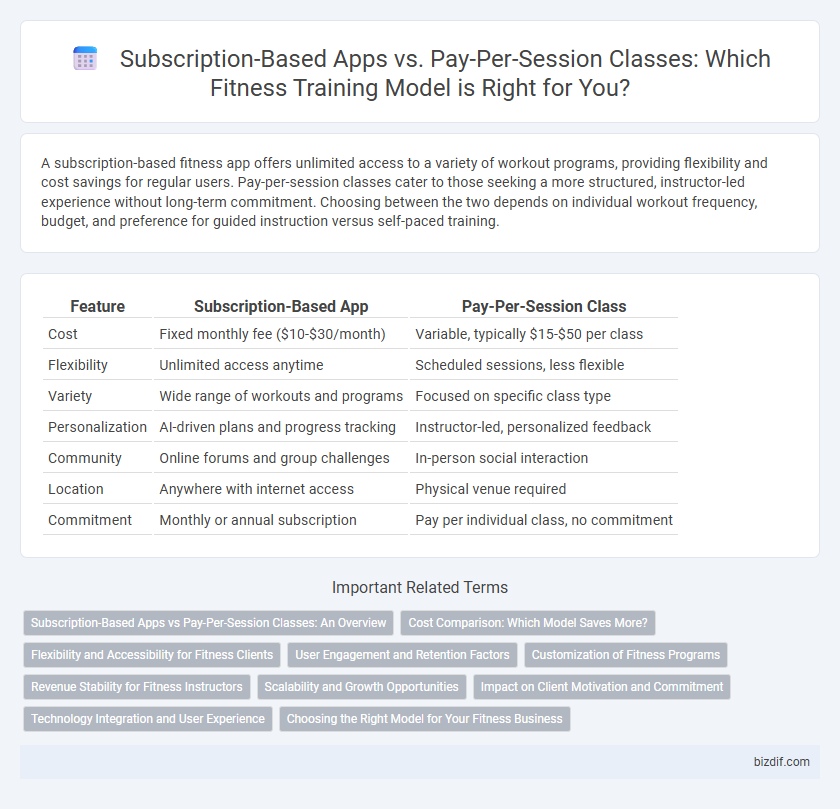A subscription-based fitness app offers unlimited access to a variety of workout programs, providing flexibility and cost savings for regular users. Pay-per-session classes cater to those seeking a more structured, instructor-led experience without long-term commitment. Choosing between the two depends on individual workout frequency, budget, and preference for guided instruction versus self-paced training.
Table of Comparison
| Feature | Subscription-Based App | Pay-Per-Session Class |
|---|---|---|
| Cost | Fixed monthly fee ($10-$30/month) | Variable, typically $15-$50 per class |
| Flexibility | Unlimited access anytime | Scheduled sessions, less flexible |
| Variety | Wide range of workouts and programs | Focused on specific class type |
| Personalization | AI-driven plans and progress tracking | Instructor-led, personalized feedback |
| Community | Online forums and group challenges | In-person social interaction |
| Location | Anywhere with internet access | Physical venue required |
| Commitment | Monthly or annual subscription | Pay per individual class, no commitment |
Subscription-Based Apps vs Pay-Per-Session Classes: An Overview
Subscription-based fitness apps offer users unlimited access to a wide range of workouts, personalized training plans, and progress tracking features for a fixed monthly fee, promoting consistency and long-term engagement. Pay-per-session classes provide flexibility and targeted instruction without ongoing commitments, appealing to users with irregular schedules or specific fitness goals. Choosing between these options depends on preferences for cost predictability, workout variety, and commitment level.
Cost Comparison: Which Model Saves More?
Subscription-based fitness apps typically offer unlimited access to a wide range of workouts for a fixed monthly fee, making them more cost-effective for frequent exercisers who use the app regularly. Pay-per-session classes can become expensive over time, especially for users attending multiple sessions weekly, as each class incurs a separate charge, often ranging from $10 to $30 per session. For individuals committed to consistent training, subscription models provide better value by spreading costs evenly, whereas occasional users might find pay-per-session more economical.
Flexibility and Accessibility for Fitness Clients
Subscription-based fitness apps offer unparalleled flexibility, allowing clients to access workouts anytime and anywhere, accommodating varied schedules and fitness levels. Pay-per-session classes provide targeted accessibility but often require rigid scheduling and location availability, limiting spontaneous or consistent exercise routines. Clients prioritizing ease of access and adaptable fitness plans tend to favor subscription models for ongoing motivation and convenience.
User Engagement and Retention Factors
Subscription-based fitness apps foster higher user engagement by providing unlimited access to diverse workouts, personalized plans, and progress tracking, which increase motivation and consistency. Pay-per-session classes often attract users seeking flexibility and variety but may suffer from lower retention due to higher costs and lack of ongoing incentives. Incorporating gamification and community features in subscription models further boosts long-term retention by creating a supportive environment and accountability.
Customization of Fitness Programs
Subscription-based fitness apps offer highly customizable workout plans tailored to individual goals, fitness levels, and preferences through advanced algorithms and user data tracking. Pay-per-session classes provide less personalized routines, focusing on standardized group workouts that may not meet specific customization needs. Personalized metrics and progress analytics in subscription apps enable continuous program adjustments, enhancing effectiveness over time.
Revenue Stability for Fitness Instructors
Subscription-based apps provide fitness instructors with consistent monthly revenue, ensuring predictable cash flow and reducing income fluctuations. In contrast, pay-per-session classes depend on variable attendance, leading to less stable earnings and potential gaps between sessions. Stable revenue from subscriptions allows instructors to invest in better content and long-term client engagement strategies.
Scalability and Growth Opportunities
Subscription-based fitness apps offer scalable growth by providing unlimited access to diverse workout content, attracting a broader user base, and generating predictable recurring revenue. Pay-per-session classes limit scalability due to reliance on individual class attendance and manual scheduling, restricting market expansion and revenue consistency. Leveraging subscription models enhances customer retention and facilitates continuous app updates, supporting long-term growth in the competitive fitness industry.
Impact on Client Motivation and Commitment
Subscription-based fitness apps often enhance client motivation by offering unlimited access to diverse workouts, fostering routine consistency and long-term commitment. Pay-per-session classes may create immediate accountability but risk lower retention due to higher cost per session and reduced flexibility. Consistent engagement through subscription models typically leads to improved adherence and sustained fitness progress compared to sporadic pay-per-session attendance.
Technology Integration and User Experience
Subscription-based fitness apps leverage advanced technology integration, including AI-driven personalized workout plans, real-time progress tracking, and seamless synchronization with wearable devices, enhancing overall user engagement and motivation. Pay-per-session classes often lack such deep technological integration, offering limited digital interaction beyond booking and basic session feedback, resulting in a less customized user experience. The continuous data analytics and adaptive training algorithms in subscription models contribute to higher retention rates and more effective fitness outcomes.
Choosing the Right Model for Your Fitness Business
Evaluating subscription-based apps against pay-per-session classes reveals key differences in revenue stability and customer retention for fitness businesses. Subscription models offer predictable monthly income and foster long-term client engagement through continuous access to content and community features. Pay-per-session classes provide flexibility and attract occasional users but may result in fluctuating earnings and less consistent client loyalty.
Subscription-based app vs Pay-per-session class Infographic

 bizdif.com
bizdif.com